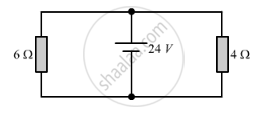Advertisements
Advertisements
प्रश्न
Two resistances when connected in parallel give resultant value of 2 ohm; when connected in series the value becomes 9 ohm. Calculate the value of each resistance.
उत्तर
Let the resistances of the two resistors be x and y.
When they are connected in parallel, we have:
1 / x + 1 / y = 1 / 2 ... (1)
When they are connected in series, we have:
x + y = 9 ... (2)
On solving equations (1) and (2), we will obtain the values of the two resistors as 3 Ω and 6 Ω.
APPEARS IN
संबंधित प्रश्न
Show how you would connect two 4 ohm resistors to produce a combined resistance of (a) 2 ohms (b) 8 ohms.
Find the current in each resistor in the circuit shown below:

A resistor has a resistance of 176 ohms. How many of these resistors should be connected in parallel so that their combination draws a current of 5 amperes from a 220 volt supply line?
Explain with the help of a labelled circuit diagram, how you will find the resistance of a combination of three resistors of resistances R1, R2 and R3 joined in parallel.
How will you connect three resistors of 2 Ω, 3 Ω and 5 Ω respectively so as to obtain a resultant of 2.5 Ω? Draw the diagram to show the arrangement.
A cell supplies a current of 1.2 A through two 2Ω resistors connected in parallel. When the resistors are connected in series, if supplies a current of 0.4 A. Calculate the internal resistance and e.m.f of the cell.
Two devices are connected between two points say A and B in parallel. The physical quantity that will remain the same between the two points is:
Four resistors each of resistance 5 Ω are connected in parallel. What is the effective resistance?
You have three resistors of values 2 Ω, 3 Ω, and 5 Ω. How will you join them so that the total resistance is less than 1 Ω? Draw a diagram and find the total resistance.
A particular resistance wire has a resistance of 3·0 ohm per metre. Find the resistance of 5 m length of a wire of the same material, but with twice the area of cross section.
